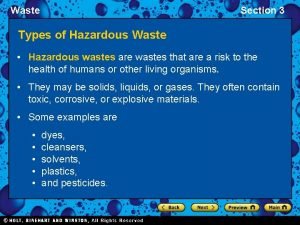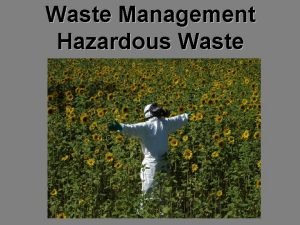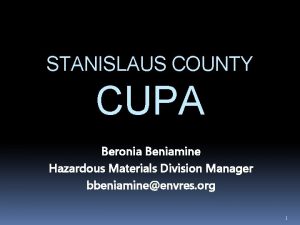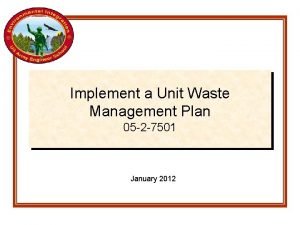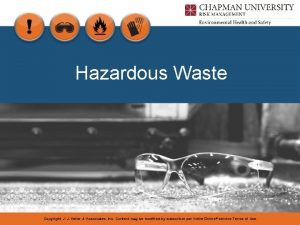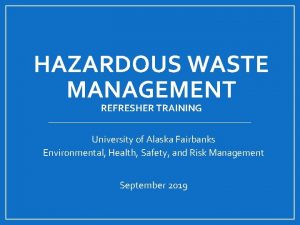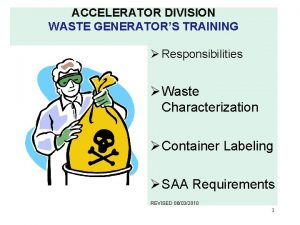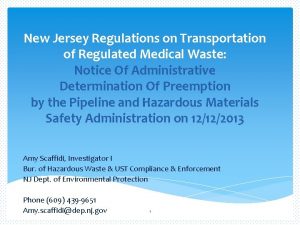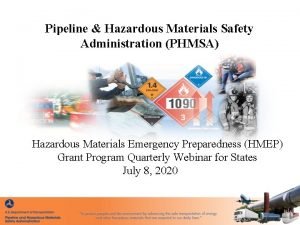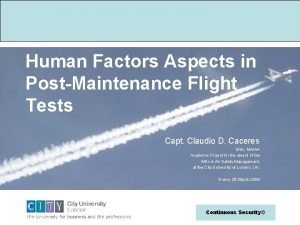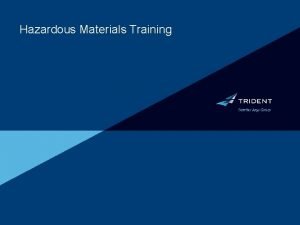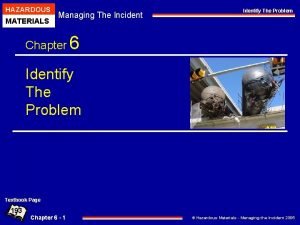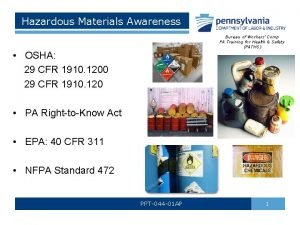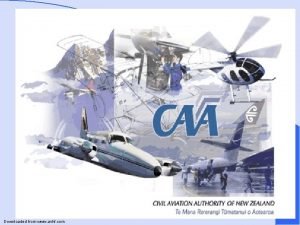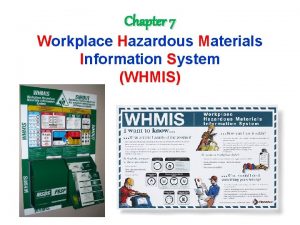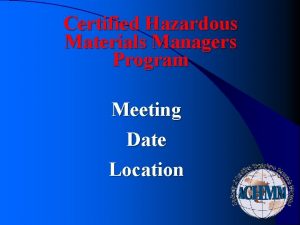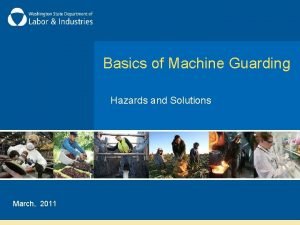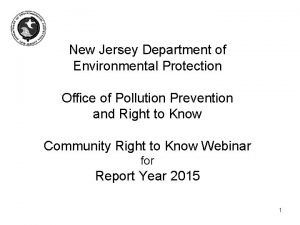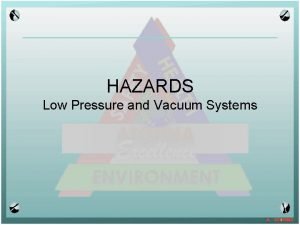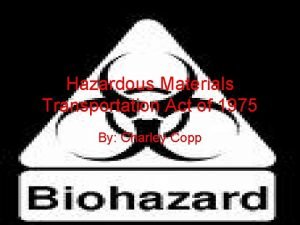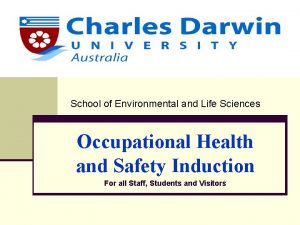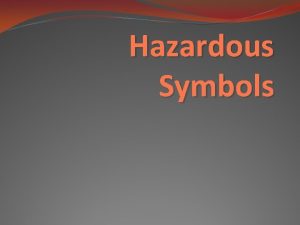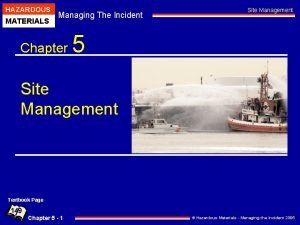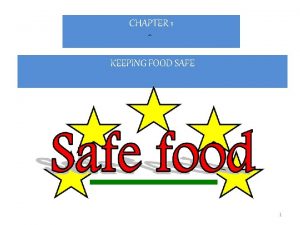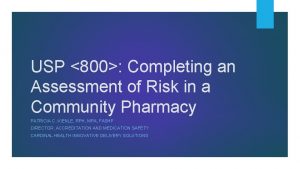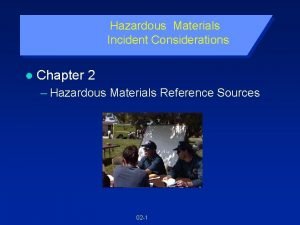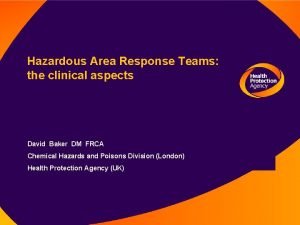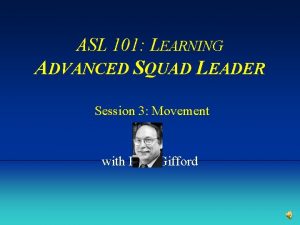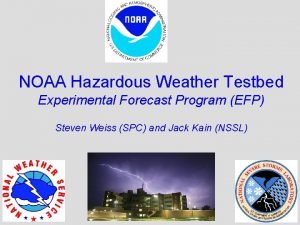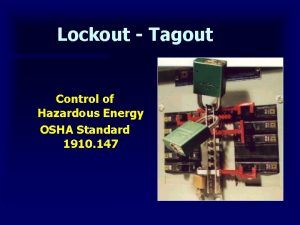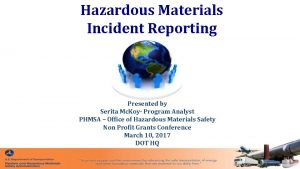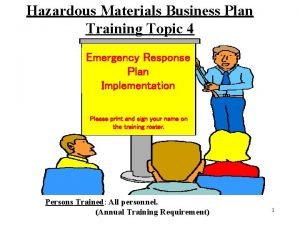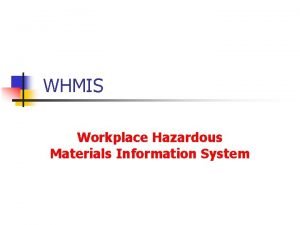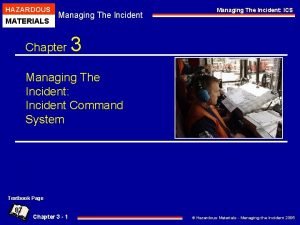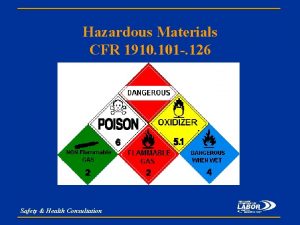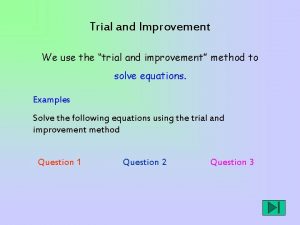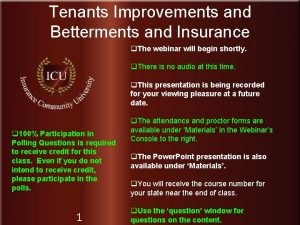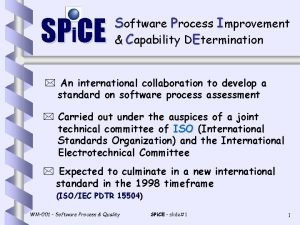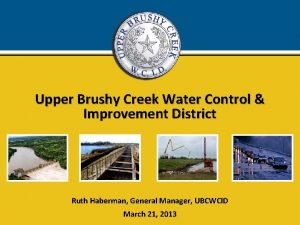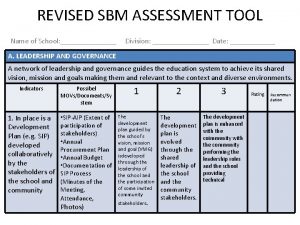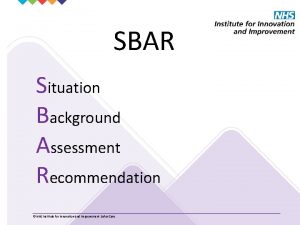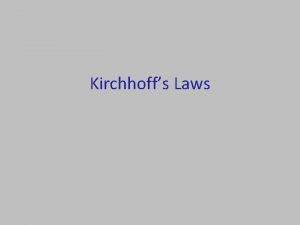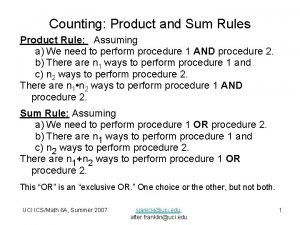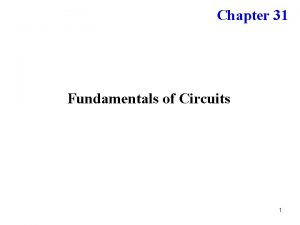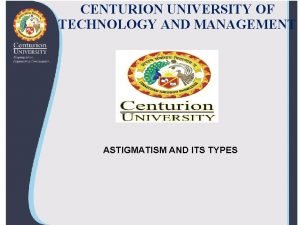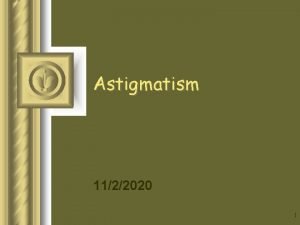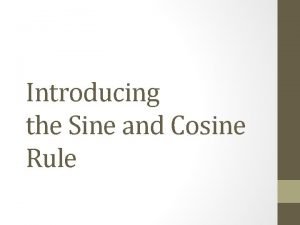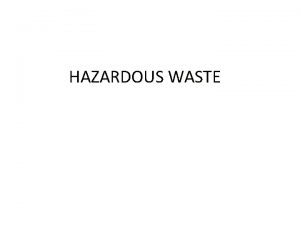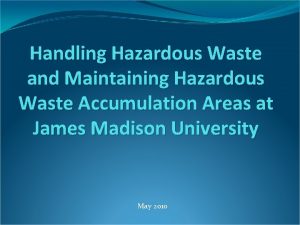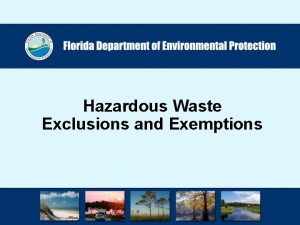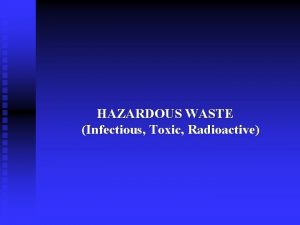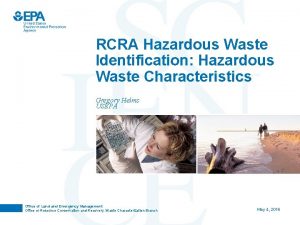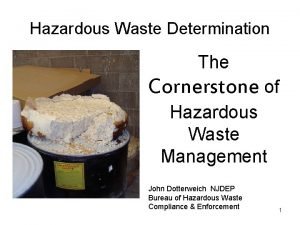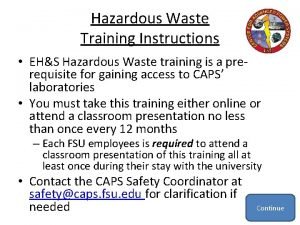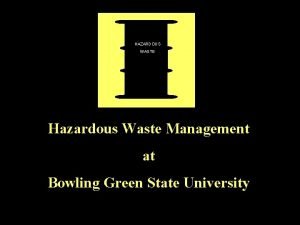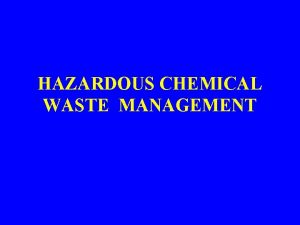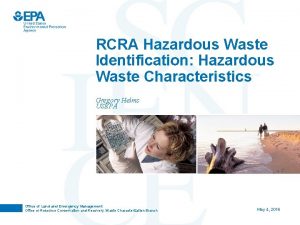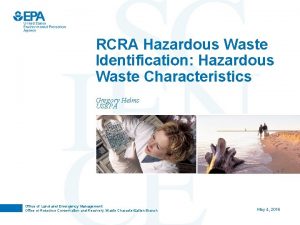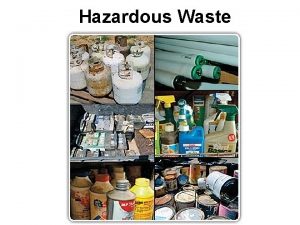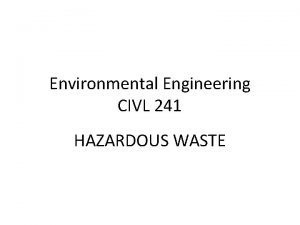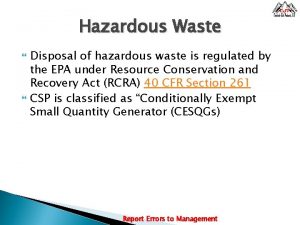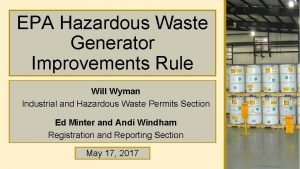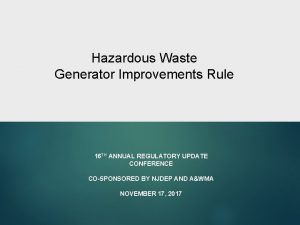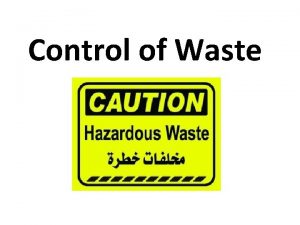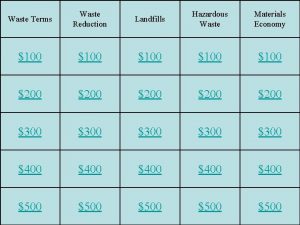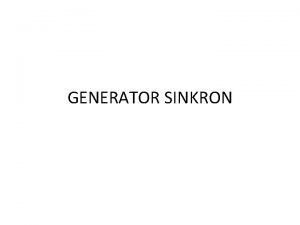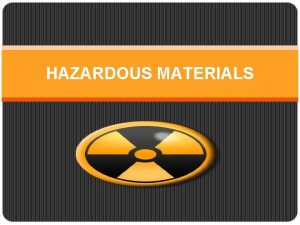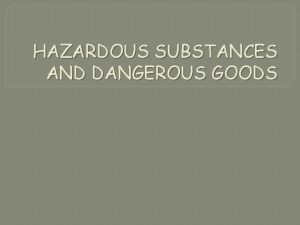Hazardous Waste Generator Improvement Rule and VSQGs Rule


![Definitions [40 CFR 260. 10] Very small quantity generator (VSQG) - is a generator Definitions [40 CFR 260. 10] Very small quantity generator (VSQG) - is a generator](https://slidetodoc.com/presentation_image_h/1659aed0a9b2e4029b2afac0ec0da590/image-3.jpg)
![Definitions [40 CFR 260. 10] Acute hazardous waste – means hazardous wastes that meet Definitions [40 CFR 260. 10] Acute hazardous waste – means hazardous wastes that meet](https://slidetodoc.com/presentation_image_h/1659aed0a9b2e4029b2afac0ec0da590/image-4.jpg)
![Waste Determination [40 CFR 262. 11] A person who generates a solid waste, as Waste Determination [40 CFR 262. 11] A person who generates a solid waste, as](https://slidetodoc.com/presentation_image_h/1659aed0a9b2e4029b2afac0ec0da590/image-5.jpg)

![Generator Category Determination [40 CFR 262. 13] A generator must determine its generator category. Generator Category Determination [40 CFR 262. 13] A generator must determine its generator category.](https://slidetodoc.com/presentation_image_h/1659aed0a9b2e4029b2afac0ec0da590/image-7.jpg)
![Generator Category Determination Wastes TO Count [40 CFR 262. 13(a)] Generators of either acute Generator Category Determination Wastes TO Count [40 CFR 262. 13(a)] Generators of either acute](https://slidetodoc.com/presentation_image_h/1659aed0a9b2e4029b2afac0ec0da590/image-8.jpg)
![Generator Category Determination Acute and Non-Acute Counting [40 CFR 262. 13(b)] Generators of both Generator Category Determination Acute and Non-Acute Counting [40 CFR 262. 13(b)] Generators of both](https://slidetodoc.com/presentation_image_h/1659aed0a9b2e4029b2afac0ec0da590/image-9.jpg)
![Generator Category Determination [40 CFR 262. 13 Table 1] Qty of acute HW generated Generator Category Determination [40 CFR 262. 13 Table 1] Qty of acute HW generated](https://slidetodoc.com/presentation_image_h/1659aed0a9b2e4029b2afac0ec0da590/image-10.jpg)
![Generator Category Determination Wastes NOT Counted [40 CFR 262. 13(c)] When making the monthly Generator Category Determination Wastes NOT Counted [40 CFR 262. 13(c)] When making the monthly](https://slidetodoc.com/presentation_image_h/1659aed0a9b2e4029b2afac0ec0da590/image-11.jpg)
![Generator Category Determination Wastes NOT Counted [40 CFR 262. 13(c)] Is spent lead-acid batteries Generator Category Determination Wastes NOT Counted [40 CFR 262. 13(c)] Is spent lead-acid batteries](https://slidetodoc.com/presentation_image_h/1659aed0a9b2e4029b2afac0ec0da590/image-12.jpg)
![Generator Category Determination Wastes NOT Counted TWICE [40 CFR 262. 13(d)] …In determining the Generator Category Determination Wastes NOT Counted TWICE [40 CFR 262. 13(d)] …In determining the](https://slidetodoc.com/presentation_image_h/1659aed0a9b2e4029b2afac0ec0da590/image-13.jpg)
![Generator Requirements [40 CFR 262. 1] After a facility has determined its correct generator Generator Requirements [40 CFR 262. 1] After a facility has determined its correct generator](https://slidetodoc.com/presentation_image_h/1659aed0a9b2e4029b2afac0ec0da590/image-14.jpg)


![Generator Requirements Violations of Independent Requirements [40 CFR 262. 10(g)(1)] (g)(1) A generator's violation Generator Requirements Violations of Independent Requirements [40 CFR 262. 10(g)(1)] (g)(1) A generator's violation](https://slidetodoc.com/presentation_image_h/1659aed0a9b2e4029b2afac0ec0da590/image-17.jpg)
![Generator Requirements Violations of a Condition for Exemption [40 CFR 262. 10(g)(2)] (g)(2) A Generator Requirements Violations of a Condition for Exemption [40 CFR 262. 10(g)(2)] (g)(2) A](https://slidetodoc.com/presentation_image_h/1659aed0a9b2e4029b2afac0ec0da590/image-18.jpg)
![Independent Requirements [40 CFR 262. 10(a)(1)(i)] Independent requirements of a Very Small Quantity Generator Independent Requirements [40 CFR 262. 10(a)(1)(i)] Independent requirements of a Very Small Quantity Generator](https://slidetodoc.com/presentation_image_h/1659aed0a9b2e4029b2afac0ec0da590/image-19.jpg)
![Conditions for Exemption for VSQG [40 CFR 262. 14(a)(1)] VSQG waste is not subject Conditions for Exemption for VSQG [40 CFR 262. 14(a)(1)] VSQG waste is not subject](https://slidetodoc.com/presentation_image_h/1659aed0a9b2e4029b2afac0ec0da590/image-20.jpg)
![Conditions for Exemption for VSQG [40 CFR 262. 14(a)(2)] (a)(2) The VSQG complies with Conditions for Exemption for VSQG [40 CFR 262. 14(a)(2)] (a)(2) The VSQG complies with](https://slidetodoc.com/presentation_image_h/1659aed0a9b2e4029b2afac0ec0da590/image-21.jpg)

![Conditions for Exemption for VSQGs [40 CFR 262. 14(a)(3)] (a)(3) If the very small Conditions for Exemption for VSQGs [40 CFR 262. 14(a)(3)] (a)(3) If the very small](https://slidetodoc.com/presentation_image_h/1659aed0a9b2e4029b2afac0ec0da590/image-23.jpg)


![Conditions for Exemption for VSQGs [40 CFR 262. 14(a)(4)] (a)(4) If the very small Conditions for Exemption for VSQGs [40 CFR 262. 14(a)(4)] (a)(4) If the very small](https://slidetodoc.com/presentation_image_h/1659aed0a9b2e4029b2afac0ec0da590/image-26.jpg)

![Conditions for Exemption for VSQGs [40 CFR 262. 14(a)(5)(i-v)] (a)(5) A VSQG that accumulates Conditions for Exemption for VSQGs [40 CFR 262. 14(a)(5)(i-v)] (a)(5) A VSQG that accumulates](https://slidetodoc.com/presentation_image_h/1659aed0a9b2e4029b2afac0ec0da590/image-28.jpg)
![Conditions for Exemption for VSQGs [40 CFR 262. 14(a)(5)(vi and vii)] (5) (continued) (vi) Conditions for Exemption for VSQGs [40 CFR 262. 14(a)(5)(vi and vii)] (5) (continued) (vi)](https://slidetodoc.com/presentation_image_h/1659aed0a9b2e4029b2afac0ec0da590/image-29.jpg)

![Conditions for Exemption for VSQGs New LQG Option [40 CFR 262. 14(a)(5)(viii)] (5)(continued) (viii) Conditions for Exemption for VSQGs New LQG Option [40 CFR 262. 14(a)(5)(viii)] (5)(continued) (viii)](https://slidetodoc.com/presentation_image_h/1659aed0a9b2e4029b2afac0ec0da590/image-31.jpg)
![Conditions for Exemption for VSQGs New LQG Option [40 CFR 262. 14(a)(5)(viii)(2)] An indication Conditions for Exemption for VSQGs New LQG Option [40 CFR 262. 14(a)(5)(viii)(2)] An indication](https://slidetodoc.com/presentation_image_h/1659aed0a9b2e4029b2afac0ec0da590/image-32.jpg)
![Conditions for Exemption for VSQGs New LQG Option [40 CFR 262. 14(a)(5)(viii)(2)] HW Characteristics Conditions for Exemption for VSQGs New LQG Option [40 CFR 262. 14(a)(5)(viii)(2)] HW Characteristics](https://slidetodoc.com/presentation_image_h/1659aed0a9b2e4029b2afac0ec0da590/image-33.jpg)
![Conditions for Exemption for VSQGs [40 CFR 262. 14(a)(5)(viii)(2)] OSHA hazard statement or pictogram Conditions for Exemption for VSQGs [40 CFR 262. 14(a)(5)(viii)(2)] OSHA hazard statement or pictogram](https://slidetodoc.com/presentation_image_h/1659aed0a9b2e4029b2afac0ec0da590/image-34.jpg)
![Conditions for Exemption for VSQGs [40 CFR 262. 14(a)(5)(viii)(2)] NPFA chemical hazard label – Conditions for Exemption for VSQGs [40 CFR 262. 14(a)(5)(viii)(2)] NPFA chemical hazard label –](https://slidetodoc.com/presentation_image_h/1659aed0a9b2e4029b2afac0ec0da590/image-35.jpg)
![State VSQGs Requirement [62 -730. 030(3), FAC] 62 -730. 030(3), FAC – VSQGs will State VSQGs Requirement [62 -730. 030(3), FAC] 62 -730. 030(3), FAC – VSQGs will](https://slidetodoc.com/presentation_image_h/1659aed0a9b2e4029b2afac0ec0da590/image-36.jpg)










![Conditions for Exemption for VSQG Episodic Generation [40 CFR 262. 14(c)] (c) A very Conditions for Exemption for VSQG Episodic Generation [40 CFR 262. 14(c)] (c) A very](https://slidetodoc.com/presentation_image_h/1659aed0a9b2e4029b2afac0ec0da590/image-47.jpg)
![Subpart L – Episodic Generation [40 CFR 262. 230] Episodic Event Episodic event means Subpart L – Episodic Generation [40 CFR 262. 230] Episodic Event Episodic event means](https://slidetodoc.com/presentation_image_h/1659aed0a9b2e4029b2afac0ec0da590/image-48.jpg)
![Subpart L – Episodic Generation [40 CFR 262. 231] Planned Episodic Event Planned episodic Subpart L – Episodic Generation [40 CFR 262. 231] Planned Episodic Event Planned episodic](https://slidetodoc.com/presentation_image_h/1659aed0a9b2e4029b2afac0ec0da590/image-49.jpg)
![Subpart L – Episodic Generation [40 CFR 262. 232(a)(1 -3)] VSQG Conditions for HW Subpart L – Episodic Generation [40 CFR 262. 232(a)(1 -3)] VSQG Conditions for HW](https://slidetodoc.com/presentation_image_h/1659aed0a9b2e4029b2afac0ec0da590/image-50.jpg)
![Subpart L – Episodic Generation [40 CFR 262. 232(a)(4)(i and ii)] (4) Accumulation – Subpart L – Episodic Generation [40 CFR 262. 232(a)(4)(i and ii)] (4) Accumulation –](https://slidetodoc.com/presentation_image_h/1659aed0a9b2e4029b2afac0ec0da590/image-51.jpg)
![Subpart L – Episodic Generation [40 CFR 262. 232(a)(4)(iii)] (4)(iii) HW must be managed Subpart L – Episodic Generation [40 CFR 262. 232(a)(4)(iii)] (4)(iii) HW must be managed](https://slidetodoc.com/presentation_image_h/1659aed0a9b2e4029b2afac0ec0da590/image-52.jpg)
![Subpart L – Episodic Generation [40 CFR 262. 232(a)(4)(iii)] (4)(iii) (cont. ) (A) Containers Subpart L – Episodic Generation [40 CFR 262. 232(a)(4)(iii)] (4)(iii) (cont. ) (A) Containers](https://slidetodoc.com/presentation_image_h/1659aed0a9b2e4029b2afac0ec0da590/image-53.jpg)
![Subpart L – Episodic Generation [40 CFR 262. 232(a)(5 -7)] (5) VSQG must comply Subpart L – Episodic Generation [40 CFR 262. 232(a)(5 -7)] (5) VSQG must comply](https://slidetodoc.com/presentation_image_h/1659aed0a9b2e4029b2afac0ec0da590/image-54.jpg)
![Subpart L – Episodic Generation [40 CFR 262. 233(a)] Generator may petition DEP/EPA for Subpart L – Episodic Generation [40 CFR 262. 233(a)] Generator may petition DEP/EPA for](https://slidetodoc.com/presentation_image_h/1659aed0a9b2e4029b2afac0ec0da590/image-55.jpg)
![Subpart L – Episodic Generation [40 CFR 262. 233(b-d)] (b) Petition must include (1) Subpart L – Episodic Generation [40 CFR 262. 233(b-d)] (b) Petition must include (1)](https://slidetodoc.com/presentation_image_h/1659aed0a9b2e4029b2afac0ec0da590/image-56.jpg)

- Slides: 57

Hazardous Waste Generator Improvement Rule and VSQGs

Rule Update Over 60 revisions and new provisions to the hazardous waste program Primary intent is to foster improved compliance and improve protection of human health and the environment. The State is in the process of adopting the new rule. It is not in effect until it is adopted and effective.
![Definitions 40 CFR 260 10 Very small quantity generator VSQG is a generator Definitions [40 CFR 260. 10] Very small quantity generator (VSQG) - is a generator](https://slidetodoc.com/presentation_image_h/1659aed0a9b2e4029b2afac0ec0da590/image-3.jpg)
Definitions [40 CFR 260. 10] Very small quantity generator (VSQG) - is a generator who generates less than or equal to the following amounts in a calendar month: (1) 100 kilograms (220 lbs) of non-acute hazardous waste; and (2) 1 kilogram (2. 2 lbs) of acute hazardous waste listed in 261. 31 or 261. 33(e) of this chapter; and (3) 100 kilograms (220 lbs) of any residue or contaminated soil, water, or other debris resulting from cleanup of a spill, into or on any land or water, of any acute hazardous waste listed in 261. 31 or 261. 33(e) of this chapter.
![Definitions 40 CFR 260 10 Acute hazardous waste means hazardous wastes that meet Definitions [40 CFR 260. 10] Acute hazardous waste – means hazardous wastes that meet](https://slidetodoc.com/presentation_image_h/1659aed0a9b2e4029b2afac0ec0da590/image-4.jpg)
Definitions [40 CFR 260. 10] Acute hazardous waste – means hazardous wastes that meet the listing criteria in 261. 11(a)(2) and therefore are either listed in 261. 31 of this chapter with the assigned hazard code of (H) or are listed in 261. 33(e) of this chapter. Non-acute hazardous waste – means all hazardous waste that are not acute hazardous waste as defined in this section.
![Waste Determination 40 CFR 262 11 A person who generates a solid waste as Waste Determination [40 CFR 262. 11] A person who generates a solid waste, as](https://slidetodoc.com/presentation_image_h/1659aed0a9b2e4029b2afac0ec0da590/image-5.jpg)
Waste Determination [40 CFR 262. 11] A person who generates a solid waste, as defined in 40 CFR 261. 2, must make an accurate determination as to whether that waste is a hazardous waste in order to ensure wastes are properly managed according to applicable RCRA regulations.

Generator Category After the facility has made an accurate hazardous waste determination on all waste streams, then the next step is to determine the facility’s generator status. A better description of all three generator categories is now found in the rule in 262. 13.
![Generator Category Determination 40 CFR 262 13 A generator must determine its generator category Generator Category Determination [40 CFR 262. 13] A generator must determine its generator category.](https://slidetodoc.com/presentation_image_h/1659aed0a9b2e4029b2afac0ec0da590/image-7.jpg)
Generator Category Determination [40 CFR 262. 13] A generator must determine its generator category. A generator's category is based on the amount of hazardous waste generated each month and may change from month to month.
![Generator Category Determination Wastes TO Count 40 CFR 262 13a Generators of either acute Generator Category Determination Wastes TO Count [40 CFR 262. 13(a)] Generators of either acute](https://slidetodoc.com/presentation_image_h/1659aed0a9b2e4029b2afac0ec0da590/image-8.jpg)
Generator Category Determination Wastes TO Count [40 CFR 262. 13(a)] Generators of either acute hazardous waste or non-acute hazardous waste. A generator who either generates acute hazardous waste or non-acute hazardous waste in a calendar month shall determine its generator category for that month by doing the following: • Counting the total amount of hazardous waste generated in the calendar month; • Subtracting from the total any amounts of waste exempt from counting as described in paragraphs (c) and (d) of this section (NOTE: This will be discussed in a separate slide); and • Determining the resulting generator category for the hazardous waste generated using Table 1 of this section.
![Generator Category Determination Acute and NonAcute Counting 40 CFR 262 13b Generators of both Generator Category Determination Acute and Non-Acute Counting [40 CFR 262. 13(b)] Generators of both](https://slidetodoc.com/presentation_image_h/1659aed0a9b2e4029b2afac0ec0da590/image-9.jpg)
Generator Category Determination Acute and Non-Acute Counting [40 CFR 262. 13(b)] Generators of both acute and non-acute HW. A generator who generates both acute HW and non-acute HW in the same calendar month shall determine its generator category for that month by doing the following: • Counting separately the total amount of acute HW and the total amount of non-acute HW generated in the calendar month; • Subtracting from each total any amounts of waste exempt from counting as described in paragraphs (c) and (d) of this section; • Determining separately the resulting generator categories for the quantities of acute and non-acute hazardous waste generated using Table 1 of this section; and • Comparing the resulting generator categories from paragraph (b)(3) of this section and applying the more stringent generator category to the accumulation and management of both non-acute HW and acute HW generated for that month.
![Generator Category Determination 40 CFR 262 13 Table 1 Qty of acute HW generated Generator Category Determination [40 CFR 262. 13 Table 1] Qty of acute HW generated](https://slidetodoc.com/presentation_image_h/1659aed0a9b2e4029b2afac0ec0da590/image-10.jpg)
Generator Category Determination [40 CFR 262. 13 Table 1] Qty of acute HW generated in a calendar month Qty of non-acute HW generated in a calendar month Qty of residues from cleanup of acute HW generated in a calendar month Generator Category Any amount LQG Any amount ≥ 1, 000 kg Any amount LQG Any amount > 100 kg LQG ≤ 1 kg > 100 kg and < 1, 000 kg ≤ 100 kg SQG ≤ 1 kg ≤ 100 kg VSQG > 1 kg
![Generator Category Determination Wastes NOT Counted 40 CFR 262 13c When making the monthly Generator Category Determination Wastes NOT Counted [40 CFR 262. 13(c)] When making the monthly](https://slidetodoc.com/presentation_image_h/1659aed0a9b2e4029b2afac0ec0da590/image-11.jpg)
Generator Category Determination Wastes NOT Counted [40 CFR 262. 13(c)] When making the monthly quantity-based determinations required by this part, the generator must include all hazardous waste that it generates, except hazardous waste that: • Is exempt from regulation under 40 CFR 261. 4(c) through (f), 261. 6(a)(3), 261. 7(a)(1), or 261. 8; • Is managed immediately upon generation only in on-site elementary neutralization units, wastewater treatment units, or totally enclosed treatment facilities as defined in 40 CFR 260. 10; • Is recycled, without prior storage or accumulation, only in an onsite process subject to regulation under 40 CFR 261. 6(c)(2); • Is used oil managed under the requirements of 40 CFR 261. 6(a)(4) and 40 CFR part 279;
![Generator Category Determination Wastes NOT Counted 40 CFR 262 13c Is spent leadacid batteries Generator Category Determination Wastes NOT Counted [40 CFR 262. 13(c)] Is spent lead-acid batteries](https://slidetodoc.com/presentation_image_h/1659aed0a9b2e4029b2afac0ec0da590/image-12.jpg)
Generator Category Determination Wastes NOT Counted [40 CFR 262. 13(c)] Is spent lead-acid batteries managed under the requirements of 40 CFR part 266 subpart G; Is universal waste managed under 40 CFR 261. 9 and 40 CFR part 273; Is a HW that is an unused commercial chemical product (…) that is generated solely as a result of a laboratory clean-out conducted at an eligible academic entity pursuant to § 262. 213. . . ; or Is managed as part of an episodic event in compliance with the conditions of subpart L of this part.
![Generator Category Determination Wastes NOT Counted TWICE 40 CFR 262 13d In determining the Generator Category Determination Wastes NOT Counted TWICE [40 CFR 262. 13(d)] …In determining the](https://slidetodoc.com/presentation_image_h/1659aed0a9b2e4029b2afac0ec0da590/image-13.jpg)
Generator Category Determination Wastes NOT Counted TWICE [40 CFR 262. 13(d)] …In determining the quantity of HW generated in a calendar month, a generator need not include: • HW removed from on-site accumulation, so long as it was previously counted • HW generated by on-site treatment (including reclamation), so long as it was previously counted • HW spent materials that are generated, reclaimed, and subsequently reused on-site, so long as such spent materials have been previously counted once.
![Generator Requirements 40 CFR 262 1 After a facility has determined its correct generator Generator Requirements [40 CFR 262. 1] After a facility has determined its correct generator](https://slidetodoc.com/presentation_image_h/1659aed0a9b2e4029b2afac0ec0da590/image-14.jpg)
Generator Requirements [40 CFR 262. 1] After a facility has determined its correct generator status and has determined that it is a VSQG, then it will need to know what requirements are for VSQGs in order to remain in compliance. Two key concepts to keep in mind with the new rule: 1. Condition for exemption 2. Independent requirement

Generator Requirements Condition for exemption means any requirement in 262. 14 (VSQGs), 262. 15, 262. 16 (SQGs), 262. 17 (LQGs), 262. 70, or Subpart K or Subpart L of this part that states an event, action, or standard that must occur or be met in order to obtain an exemption from any applicable requirement in Parts 124, 264 through 268, and 270 of this chapter, or from any requirement for notification under section 3010 of RCRA.

Generator Requirements Independent requirement means a requirement of Part 262 that states an event, action, or standard that must occur or be met; and that applies without relation to, or irrespective of, the purpose of obtaining a conditional exemption from storage facility permit, interim status, and operating requirements under §§ 262. 14 (VSQGs), 262. 15, 262. 16 (SQGs), 262. 17 (LQGs), or Subpart K or Subpart L of this Part.
![Generator Requirements Violations of Independent Requirements 40 CFR 262 10g1 g1 A generators violation Generator Requirements Violations of Independent Requirements [40 CFR 262. 10(g)(1)] (g)(1) A generator's violation](https://slidetodoc.com/presentation_image_h/1659aed0a9b2e4029b2afac0ec0da590/image-17.jpg)
Generator Requirements Violations of Independent Requirements [40 CFR 262. 10(g)(1)] (g)(1) A generator's violation of an independent requirement is subject to penalty and injunctive relief under section 3008 of RCRA.
![Generator Requirements Violations of a Condition for Exemption 40 CFR 262 10g2 g2 A Generator Requirements Violations of a Condition for Exemption [40 CFR 262. 10(g)(2)] (g)(2) A](https://slidetodoc.com/presentation_image_h/1659aed0a9b2e4029b2afac0ec0da590/image-18.jpg)
Generator Requirements Violations of a Condition for Exemption [40 CFR 262. 10(g)(2)] (g)(2) A generator's noncompliance with a condition for exemption in this part is not subject to penalty or injunctive relief under section 3008 of RCRA as a violation of a 40 CFR Part 262 condition for exemption. Noncompliance by any generator with an applicable condition for exemption from storage permit and operations requirements means that the facility is a storage facility operating without an exemption from the permit, …, and operations requirements in 40 CFR Parts 124, 264 through 267, and 270 of this chapter, and the notification requirements of section 3010 of RCRA. Without an exemption, any violations of such storage requirements are subject to penalty and injunctive relief under section 3008 of RCRA.
![Independent Requirements 40 CFR 262 10a1i Independent requirements of a Very Small Quantity Generator Independent Requirements [40 CFR 262. 10(a)(1)(i)] Independent requirements of a Very Small Quantity Generator](https://slidetodoc.com/presentation_image_h/1659aed0a9b2e4029b2afac0ec0da590/image-19.jpg)
Independent Requirements [40 CFR 262. 10(a)(1)(i)] Independent requirements of a Very Small Quantity Generator (VSQG): (a)(1)(i) (A) Section 262. 11(a) through (d) - Hazardous waste determination and recordkeeping; and (B) Section 262. 13 - Generator category determination
![Conditions for Exemption for VSQG 40 CFR 262 14a1 VSQG waste is not subject Conditions for Exemption for VSQG [40 CFR 262. 14(a)(1)] VSQG waste is not subject](https://slidetodoc.com/presentation_image_h/1659aed0a9b2e4029b2afac0ec0da590/image-20.jpg)
Conditions for Exemption for VSQG [40 CFR 262. 14(a)(1)] VSQG waste is not subject to the requirements of Parts 124, 262 (except 262. 10 -262. 14) through 268, and 270 provided: (a)(1) The VSQG generates less than or equal to: • 100 kg (220 lbs) of non-acute waste; and • 1 kg (2. 2 lbs) of acute waste • 100 kg (220 lbs) of any residue or contaminated soil, water, debris from spill cleanup of acute waste
![Conditions for Exemption for VSQG 40 CFR 262 14a2 a2 The VSQG complies with Conditions for Exemption for VSQG [40 CFR 262. 14(a)(2)] (a)(2) The VSQG complies with](https://slidetodoc.com/presentation_image_h/1659aed0a9b2e4029b2afac0ec0da590/image-21.jpg)
Conditions for Exemption for VSQG [40 CFR 262. 14(a)(2)] (a)(2) The VSQG complies with 262. 11(a)-(d): (a) HW determination made at point of generation (b) Determine if solid waste is excluded from regulation under 261. 4 (c) Determine if waste is listed under Part 261 Subpart D (d) Determine if waste exhibits HW characteristic identified in Part 261 Subpart C

HW Determinations Hazardous waste determinations are covered more thoroughly in a separate Power. Point. VSQGs need to perform a hazardous waste determination, but the documentation requirements in 262. 11(f) for recordkeeping requirements and (g) for waste code identification do not apply to VSQGs. But it still would be a good practice to have both available.
![Conditions for Exemption for VSQGs 40 CFR 262 14a3 a3 If the very small Conditions for Exemption for VSQGs [40 CFR 262. 14(a)(3)] (a)(3) If the very small](https://slidetodoc.com/presentation_image_h/1659aed0a9b2e4029b2afac0ec0da590/image-23.jpg)
Conditions for Exemption for VSQGs [40 CFR 262. 14(a)(3)] (a)(3) If the very small quantity generator accumulates at any time greater than 1 kilogram (2. 2 lbs) of acute hazardous waste or 100 kilograms (220 lbs) of any residue or contaminated soil, water, or other debris resulting from the cleanup of a spill, into or on any land or water, of any acute hazardous waste listed in §§ 261. 31 or 261. 33(e) of this chapter, all quantities of that acute hazardous waste are subject to the following additional conditions for exemption: (i) Such waste is held on site for no more than 90 days beginning on the date when the accumulated wastes exceed the amounts provided above; and (ii) The conditions for exemption in § 262. 17(a) through (g) [LQG requirements].

Examples of Acute Hazardous Waste Nicotine Containing Products (P 075) Warfarin >0. 3% (P 001)

Nicotine: P 075 waste code Used nicotine patches and gum are not hazardous waste because the listing only applies to unused commercial chemical products and spill residues Unused nicotine patches and gum are hazardous waste if discarded
![Conditions for Exemption for VSQGs 40 CFR 262 14a4 a4 If the very small Conditions for Exemption for VSQGs [40 CFR 262. 14(a)(4)] (a)(4) If the very small](https://slidetodoc.com/presentation_image_h/1659aed0a9b2e4029b2afac0ec0da590/image-26.jpg)
Conditions for Exemption for VSQGs [40 CFR 262. 14(a)(4)] (a)(4) If the very small quantity generator accumulates at any time 1, 000 kilograms (2, 200 lbs) or greater of nonacute hazardous waste, all quantities of that hazardous waste are subject to the following additional conditions for exemption: (i) Such waste is held on site for no more than 180 days, beginning on the date when the accumulated waste exceed the amounts provided above; (ii) The quantity of waste accumulated on site never exceeds 6, 000 kilograms (13, 200 lbs); and (iii) The conditions for exemption in § 262. 16(b)(2) through (f) [SQG requirements].

VSQG Accumulating >1000 kgs of Non-Acute Waste
![Conditions for Exemption for VSQGs 40 CFR 262 14a5iv a5 A VSQG that accumulates Conditions for Exemption for VSQGs [40 CFR 262. 14(a)(5)(i-v)] (a)(5) A VSQG that accumulates](https://slidetodoc.com/presentation_image_h/1659aed0a9b2e4029b2afac0ec0da590/image-28.jpg)
Conditions for Exemption for VSQGs [40 CFR 262. 14(a)(5)(i-v)] (a)(5) A VSQG that accumulates HW in amounts less than or equal to those in paragraphs (a)(3) and (4) of this Section must treat or dispose of its HW in an on-site facility or ensure delivery to an off-site TSD, either of which is: (i) Permitted under RCRA to manage HW (ii) In Interim Status under 40 CFR Parts 265 and 270 (iii) Authorized to manage HW by the State (iv) Permitted to manage municipal waste… (v) Permitted to manage non-municipal non-HW…
![Conditions for Exemption for VSQGs 40 CFR 262 14a5vi and vii 5 continued vi Conditions for Exemption for VSQGs [40 CFR 262. 14(a)(5)(vi and vii)] (5) (continued) (vi)](https://slidetodoc.com/presentation_image_h/1659aed0a9b2e4029b2afac0ec0da590/image-29.jpg)
Conditions for Exemption for VSQGs [40 CFR 262. 14(a)(5)(vi and vii)] (5) (continued) (vi) A facility which (A) beneficially uses or reuses, or legitimately recycles or reclaims its waste; or (B) treats its waste prior to beneficial use or reuse, or legitimate recycling or reclamation (vii) For universal waste, a universal waste handler or destination facility.

VSQGs and LQGs Under the Control of the Same Person New option The new rule allows for flexibility for some LQGs and VSQGs.
![Conditions for Exemption for VSQGs New LQG Option 40 CFR 262 14a5viii 5continued viii Conditions for Exemption for VSQGs New LQG Option [40 CFR 262. 14(a)(5)(viii)] (5)(continued) (viii)](https://slidetodoc.com/presentation_image_h/1659aed0a9b2e4029b2afac0ec0da590/image-31.jpg)
Conditions for Exemption for VSQGs New LQG Option [40 CFR 262. 14(a)(5)(viii)] (5)(continued) (viii) A LQG under the control of the same person (see 260. 10) as the VSQG, provided the VSQG marks its containers with: (1) the words “Hazardous Waste” and (2) An indication of the hazards of the contents
![Conditions for Exemption for VSQGs New LQG Option 40 CFR 262 14a5viii2 An indication Conditions for Exemption for VSQGs New LQG Option [40 CFR 262. 14(a)(5)(viii)(2)] An indication](https://slidetodoc.com/presentation_image_h/1659aed0a9b2e4029b2afac0ec0da590/image-32.jpg)
Conditions for Exemption for VSQGs New LQG Option [40 CFR 262. 14(a)(5)(viii)(2)] An indication of the hazards of the contents include, but are not limited to: • HW Characteristics • DOT Hazard Communication – 49 CFR Part 172 Subparts E or F • OSHA hazard statement or pictogram – 29 CFR 1910. 1200 • NPFA chemical hazard label – Code 704
![Conditions for Exemption for VSQGs New LQG Option 40 CFR 262 14a5viii2 HW Characteristics Conditions for Exemption for VSQGs New LQG Option [40 CFR 262. 14(a)(5)(viii)(2)] HW Characteristics](https://slidetodoc.com/presentation_image_h/1659aed0a9b2e4029b2afac0ec0da590/image-33.jpg)
Conditions for Exemption for VSQGs New LQG Option [40 CFR 262. 14(a)(5)(viii)(2)] HW Characteristics - Ignitable, Corrosive, Reactive, Toxic DOT Hazard Communication – 49 CFR Part 172 Subparts E or F
![Conditions for Exemption for VSQGs 40 CFR 262 14a5viii2 OSHA hazard statement or pictogram Conditions for Exemption for VSQGs [40 CFR 262. 14(a)(5)(viii)(2)] OSHA hazard statement or pictogram](https://slidetodoc.com/presentation_image_h/1659aed0a9b2e4029b2afac0ec0da590/image-34.jpg)
Conditions for Exemption for VSQGs [40 CFR 262. 14(a)(5)(viii)(2)] OSHA hazard statement or pictogram – 29 CFR 1910. 1200
![Conditions for Exemption for VSQGs 40 CFR 262 14a5viii2 NPFA chemical hazard label Conditions for Exemption for VSQGs [40 CFR 262. 14(a)(5)(viii)(2)] NPFA chemical hazard label –](https://slidetodoc.com/presentation_image_h/1659aed0a9b2e4029b2afac0ec0da590/image-35.jpg)
Conditions for Exemption for VSQGs [40 CFR 262. 14(a)(5)(viii)(2)] NPFA chemical hazard label – Code 704
![State VSQGs Requirement 62 730 0303 FAC 62 730 0303 FAC VSQGs will State VSQGs Requirement [62 -730. 030(3), FAC] 62 -730. 030(3), FAC – VSQGs will](https://slidetodoc.com/presentation_image_h/1659aed0a9b2e4029b2afac0ec0da590/image-36.jpg)
State VSQGs Requirement [62 -730. 030(3), FAC] 62 -730. 030(3), FAC – VSQGs will need written records of proper disposal. (3) A conditionally exempt small quantity generator (CESQG) which chooses to send its hazardous waste to an off-site treatment, storage or disposal facility shall document delivery of its hazardous waste through written receipts and other records which are retained for at least three years. The written receipts and other records shall include names and addresses of the generator and the treatment, storage or disposal facility, the type and amount of hazardous waste delivered, and the date of shipment.

Hazardous waste may not be thrown into the trash

Hazardous waste may not be thrown into the trash

Hazardous waste may not be evaporated

Hazardous waste may not be evaporated

Hazardous Waste Containers of Volatile Liquids Should be Kept Closed to Keep the Waste from Evaporating

Hazardous Waste Containers of Volatile Liquids Should be Kept Closed to Keep the Waste from Evaporating

Hazardous Waste Containers of Volatile Liquids Should be Kept Closed to Keep the Waste from Evaporating

Proper Management of Hazardous Waste

Proper Management of Hazardous Waste

Episodic Generation The new rule covers episodic hazardous waste generation
![Conditions for Exemption for VSQG Episodic Generation 40 CFR 262 14c c A very Conditions for Exemption for VSQG Episodic Generation [40 CFR 262. 14(c)] (c) A very](https://slidetodoc.com/presentation_image_h/1659aed0a9b2e4029b2afac0ec0da590/image-47.jpg)
Conditions for Exemption for VSQG Episodic Generation [40 CFR 262. 14(c)] (c) A very small quantity generator experiencing an episodic event may generate and accumulate hazardous waste in accordance with subpart L of this part in lieu of §§ 262. 15, 262. 16, and 262. 17.
![Subpart L Episodic Generation 40 CFR 262 230 Episodic Event Episodic event means Subpart L – Episodic Generation [40 CFR 262. 230] Episodic Event Episodic event means](https://slidetodoc.com/presentation_image_h/1659aed0a9b2e4029b2afac0ec0da590/image-48.jpg)
Subpart L – Episodic Generation [40 CFR 262. 230] Episodic Event Episodic event means an activity or activities, either planned or unplanned, that does not normally occur during generator operations, resulting in an increase in the generation of hazardous wastes that exceeds the calendar month quantity limits for the generator's usual category.
![Subpart L Episodic Generation 40 CFR 262 231 Planned Episodic Event Planned episodic Subpart L – Episodic Generation [40 CFR 262. 231] Planned Episodic Event Planned episodic](https://slidetodoc.com/presentation_image_h/1659aed0a9b2e4029b2afac0ec0da590/image-49.jpg)
Subpart L – Episodic Generation [40 CFR 262. 231] Planned Episodic Event Planned episodic event means an episodic event that the generator planned and prepared for, including regular maintenance, tank cleanouts, short-term projects, and removal of excess chemical inventory Unplanned Episodic Event Unplanned episodic event means an episodic event that the generator did not plan or reasonably did not expect to occur, including production process upsets, product recalls, accidental spills, or “acts of nature, ” such as tornado, hurricane, or flood.
![Subpart L Episodic Generation 40 CFR 262 232a1 3 VSQG Conditions for HW Subpart L – Episodic Generation [40 CFR 262. 232(a)(1 -3)] VSQG Conditions for HW](https://slidetodoc.com/presentation_image_h/1659aed0a9b2e4029b2afac0ec0da590/image-50.jpg)
Subpart L – Episodic Generation [40 CFR 262. 232(a)(1 -3)] VSQG Conditions for HW generated during episodic event required to maintain existing generator category (a) (1) One event per year (2) Notification • 8700 -12 FL submitted 30 calendar days prior to planned event • Telephone, fax, or email notification within 72 hours of unplanned event and subsequent submittal of 8700 -12 (3) EPA ID Number
![Subpart L Episodic Generation 40 CFR 262 232a4i and ii 4 Accumulation Subpart L – Episodic Generation [40 CFR 262. 232(a)(4)(i and ii)] (4) Accumulation –](https://slidetodoc.com/presentation_image_h/1659aed0a9b2e4029b2afac0ec0da590/image-51.jpg)
Subpart L – Episodic Generation [40 CFR 262. 232(a)(4)(i and ii)] (4) Accumulation – VSQG prohibited from accumulating episodic HW on drip pads or in containment building (i) Containers – VSQG must mark or label containers: (A) “Episodic Hazardous Waste” (B) With an indication of the hazards of the contents (C) Date episodic event began – clearly visible (ii) Tanks – VSQG accumulating in tanks must: (A) (B) (C) (D) Label tank “Episodic Hazardous Waste” Label tank with an indication of the hazards of the contents Record date upon which episodic event begins Keep inventory logs or records with above information on site and available for inspection
![Subpart L Episodic Generation 40 CFR 262 232a4iii 4iii HW must be managed Subpart L – Episodic Generation [40 CFR 262. 232(a)(4)(iii)] (4)(iii) HW must be managed](https://slidetodoc.com/presentation_image_h/1659aed0a9b2e4029b2afac0ec0da590/image-52.jpg)
Subpart L – Episodic Generation [40 CFR 262. 232(a)(4)(iii)] (4)(iii) HW must be managed in a manner that minimizes the possibility of a fire, explosion, or release of HW or HW constituents to the air, soil, or water
![Subpart L Episodic Generation 40 CFR 262 232a4iii 4iii cont A Containers Subpart L – Episodic Generation [40 CFR 262. 232(a)(4)(iii)] (4)(iii) (cont. ) (A) Containers](https://slidetodoc.com/presentation_image_h/1659aed0a9b2e4029b2afac0ec0da590/image-53.jpg)
Subpart L – Episodic Generation [40 CFR 262. 232(a)(4)(iii)] (4)(iii) (cont. ) (A) Containers • Must be in good condition • Compatible with the HW • Closed except when adding or removing waste (B) Tanks • Must be in good condition • Compatible with the HW accumulated • Must have procedures to prevent overflow • Must be inspected once each operating day
![Subpart L Episodic Generation 40 CFR 262 232a5 7 5 VSQG must comply Subpart L – Episodic Generation [40 CFR 262. 232(a)(5 -7)] (5) VSQG must comply](https://slidetodoc.com/presentation_image_h/1659aed0a9b2e4029b2afac0ec0da590/image-54.jpg)
Subpart L – Episodic Generation [40 CFR 262. 232(a)(5 -7)] (5) VSQG must comply with manifest provisions (6) VSQG must ship episodic HW within 60 calendar days from start of event to designated facility (7) VSQG must maintain following records for 3 years (i) Beginning and end dates of episodic event (ii) Description of the episodic event (iii) Description of the types and quantities of HW generated during the event (iv) Description of how the HW was managed and name of designated facility that received the HW (v) Name(s) of the HW transporters (vi) Approval letter from DEP/EPA if the generator petitioned to conduct one additional episodic event per calendar year
![Subpart L Episodic Generation 40 CFR 262 233a Generator may petition DEPEPA for Subpart L – Episodic Generation [40 CFR 262. 233(a)] Generator may petition DEP/EPA for](https://slidetodoc.com/presentation_image_h/1659aed0a9b2e4029b2afac0ec0da590/image-55.jpg)
Subpart L – Episodic Generation [40 CFR 262. 233(a)] Generator may petition DEP/EPA for a 2 nd episodic event in a calendar year if: (a) (1) VSQG already held a planned event, generator may petition for an additional unplanned event within 72 hours of the unplanned event (2) VSQG already held an unplanned episodic event, generator may petition DEP/EPA for an additional planned episodic event
![Subpart L Episodic Generation 40 CFR 262 233bd b Petition must include 1 Subpart L – Episodic Generation [40 CFR 262. 233(b-d)] (b) Petition must include (1)](https://slidetodoc.com/presentation_image_h/1659aed0a9b2e4029b2afac0ec0da590/image-56.jpg)
Subpart L – Episodic Generation [40 CFR 262. 233(b-d)] (b) Petition must include (1) Reason(s) why additional episodic event is needed and the nature of the event (2) Estimated amount of HW to be managed from the event (3) How the HW is to be managed (4) Estimated length of time needed to complete management of the HW generated – not to exceed 60 days (5) Information regarding the previous episodic event, including the nature of the event, whether it was a planned or unplanned event, and how the generator complied with the conditions (c) Petition must be made to the DEP/EPA in writing, either on paper or electronically (d) Generator must retain written approval in its records for 3 years from the date the event ended

Questions?
 Solid and hazardous waste
Solid and hazardous waste Section 3 hazardous waste answers
Section 3 hazardous waste answers Hospital waste management introduction
Hospital waste management introduction Msw apes
Msw apes Hazardous waste examples
Hazardous waste examples Stanislaus county hazardous waste
Stanislaus county hazardous waste Waste management references
Waste management references Hazardous waste transportation
Hazardous waste transportation Rcra hazardous waste refresher
Rcra hazardous waste refresher Human design projector type
Human design projector type Waste generator responsibilities
Waste generator responsibilities Nj regulated medical waste
Nj regulated medical waste Pipeline and hazardous materials administration
Pipeline and hazardous materials administration Aviation hazardous attitudes
Aviation hazardous attitudes Hazardous materials table
Hazardous materials table Hazardous materials table
Hazardous materials table Hazardous
Hazardous Hazwoper
Hazwoper Five hazardous attitudes
Five hazardous attitudes Aviation hazardous attitudes
Aviation hazardous attitudes What shape and color are the whmis 2015 symbols
What shape and color are the whmis 2015 symbols Certified hazardous materials manager
Certified hazardous materials manager In running nip points
In running nip points Nj crtk environmental hazardous substances
Nj crtk environmental hazardous substances Low pressure vacuum
Low pressure vacuum Hazardous materials transportation act of 1975
Hazardous materials transportation act of 1975 Hazardous area training darwin
Hazardous area training darwin Hazardous symbols
Hazardous symbols Hazardous materials managing the incident
Hazardous materials managing the incident Potentially hazardous food is usually moist
Potentially hazardous food is usually moist Hazardous drug api
Hazardous drug api On july 18 2001 a train carrying hazardous chemicals
On july 18 2001 a train carrying hazardous chemicals Hazardous materials reference books
Hazardous materials reference books Hazardous area response teams
Hazardous area response teams Hazardous movement asl
Hazardous movement asl Noaa experimental forecast
Noaa experimental forecast Hazardous energy
Hazardous energy Hazardous materials incident report
Hazardous materials incident report Hazardous materials business plan
Hazardous materials business plan Hazardous chemicals
Hazardous chemicals Hazardous materials managing the incident
Hazardous materials managing the incident Osha psm 1910
Osha psm 1910 Trial and improvement
Trial and improvement If you cant measure it you can't manage it
If you cant measure it you can't manage it Improvements and betterments insurance
Improvements and betterments insurance Spi in software engineering
Spi in software engineering Brushy creek water
Brushy creek water Sbm assessment tool 2020
Sbm assessment tool 2020 Sbar tool
Sbar tool The sine rule for a triangle states that
The sine rule for a triangle states that Sohcahtoa rule
Sohcahtoa rule Kirchhoff's junction rule states that
Kirchhoff's junction rule states that Sum rule product rule
Sum rule product rule Kirchhoff loop rule
Kirchhoff loop rule What is with the rule and against the rule astigmatism
What is with the rule and against the rule astigmatism With the rule astigmatism axis
With the rule astigmatism axis Against the rule astigmatism
Against the rule astigmatism When to use the sine rule
When to use the sine rule

